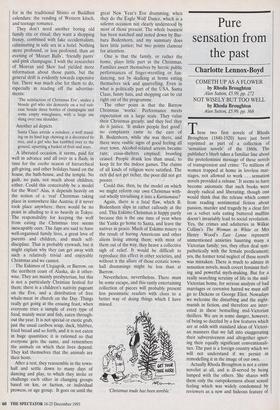BOOKS
They order things better in Alaska
Eric Christiansen
UNWRAPPING CHRISTMAS by Daniel Miller Clarendon, £25, pp. 239 It tends to make adults very unhappy; there is little doubt about that. In the UK and the USA, at least, suicides, divorces, mental breakdowns and domestic violence occur more frequently than usual, and there is a note of dread, despair and hyste- ria wherever Christmas is discussed away from the children. Their joys are more difficult to measure than our sorrows; but they are not necessarily increased by those sorrows. Is there not some less self- lacerating way of making children happy? Yes, of course there is. You can send them money and keep well out of their way. MI, but that won't do. That's not Christmas.
So what is Christmas? The newspapers always run those chirpy pieces about how the whole thing is a sentimental fraud, invented by Dickens and Prince Albert. Nonsense. It is a commercial fraud, for which A Christmas Carol is not responsible. The whole retail and much of the manufac- turing economy depends on the coercion of tax-payers into buying mountains of over- priced trash for two months of the year. Therefore the fraud is unindictable, invincible, triumphant, laughing in the faces of its victims, rolling through the malls in glory, sucking up the bank-notes of the poor, like old Doc Duvalier in reverse. It wears a mask of profusion, joy, and love in which to conduct operations of a severe- ly commercial character. I learn from this intriguing collection of essays that the American artist Nast, who invented the image of their 'Santa Claus', was inspired by the fur-lined costumes sported by the Astor family in the 1860s. He converted Claus from the unruly, sweet-distributing Imp of the 1820s into the burly, belted god of consumerism we now worship. No wonder the cathedral clergy of Dijon hanged and burned the jovial American effigy of Christmas at 3 pm on December 1951; no wonder Claude Levi-Strauss found this action significant, and concluded that the priests had unwittingly restored the culmination of the pagan Saturnalian ritual — a favourite delusion of social anthropologists, that sacrificial business. The wonder is only that the public execu- tion of Father Christmas is so rare in this country, when it seems that millions will be cursing him in their hearts before the end of 1993.
However, such people deserve no partic- ular sympathy. Their misery is usually self- induced, of trying to live up to impossible expectations derived not from tradition or religion, but from fashion. Another good piece in this book is entitled 'The Great Christmas Quarrel and Other Swedish Tra- ditions', and it tells in poignant detail of a wretched boreal nation annually reduced to tears by aiming for the historically and technically perfect Christmas, the simulta- neous fulfilment of everybody's expecta- tions of everybody else and of life in general. I don't think it's that bad in Eng- land. People seem to be reasonably satis- fied with the family get-together that doesn't involve excessive physical violence or serious attempts at self-destruction. However, the Swedish Yule should always be borne in mind as a warning of what may lie ahead for the perfectionists.
Others may well ask, 'But what is this festival meant to be? Is it so desperately arcane that we need to buy a book by a gang of social anthropologists to find out? Are we that stupid?'
A reasonable question, I think. However, one of the more reassuring things about this particular gang is that (apart from Levi-Strauss) they just describe things as they are and leave you to draw conclusions. The history of the subject is so long and complicated that it really doesn't help very much: Mr Miller's 'Theory of Christmas' goes through the tangled roots in a gingerly fashion, and leaves them already in that condition well before Christ's birth was brought in to increase the confusion. It has all been going on so long that I suspect that we are genetically programmed to celebrate something at the Winter Solstice, no great matter what. The survey of eight current varieties of celebration that follows also suggests this.
They range from Trinidad, where it is mainly an opportunity for interior decora- tion and the singing of unintelligible 'Span- ish' songs, to Alaska, or at least one town in Alaska, to which we shall return; and it takes in Japan, where Kurisumasu is now very big, and rests on two complementary themes not, it seems, adequately provided
for in the traditional Shinto or Buddhist calendars: the vending of Western kitsch, and teenage romance.
They don't need another boring old family rite or ritual; they want a shopping frenzy, combined with fake occidentalism, culminating in safe sex in a hotel. Nothing more profound, or less profound, than an evening of 'Mozart Balls', 'friendly pants' and pink champagne. I wish the researches of Moeran and Skov had yielded more information about those pants, but the general drift is evidently towards expensive fun. There was much else for them to do, especially in reading off the advertise- ments:
`The satisfaction of Christmas Eve', smiles a blonde girl who sits demurely on a red suit- case beside three bottles of champagne and some empty wineglasses, with a large axe slung over one shoulder.
Another ad depicts
Santa Claus astride a reindeer, a wolf stand- ing on its hind legs chewing at a decorated fir tree, and a girl who has tumbled over to the ground, upsetting a basket of fruit and stars.
A liberated occasion, it seems, paid for well in advance and all over in a flash, in time for the oseibo season of hierarchical gift-giving, and other holidays based on the house, the bath-house, and the temple. No guilt, no pain, not much about children, either. Could this conceivably be a model for the West? Alas, it depends heavily on the notion of a 'real' Christmas taking place in somewhere like Austria; if it never took place anywhere, there would be no point in alluding to it so heavily in Tokyo. The responsibility for keeping the wolf from eating the Christmas tree seems inescapably ours. The Japs are said to have well-organised family lives, a great love of parents and children, and much self- discipline. That is probably eyewash, but it might explain why they can get away with such a relatively trivial and enjoyable Christmas and we cannot.
The Eskimos of Utqiagvik, or Barrow, on the northern coast of Alaska, do it other- wise. They are mainly presbyterian, but this is not a particularly Christian festival for them; there is a children's nativity pageant on the Eve, and a distribution of free whale-meat in church on the Day. Things really get going at the ensuing feast, when everyone tries a sample of every type of food, mainly meat and fish, eaten through- out the year. It is not special or exotic grub, just the usual caribou soup, duck, blubber, fried bread and so forth, and it is not eaten in huge quantities; it is rationed so that everyone gets the same, and remembers the animals on which their lives depend. They kid themselves that the animals are their hosts.
After a rest, they reassemble in the town- hall and settle down to many days of dancing and play, to which they invite or challenge each other in changing groups based on kin, or faction, or individual prowess, or age group. It goes on until the great New Year's Eve drumming, when they do the Eagle Wolf Dance, which is a solemn occasion not clearly understood by most of those present. The whole business has been watched and noted down by Bar- bara Bodenhorn, and my summary does hers little justice; but two points clamour for attention.
One is that the family, or rather the home, plays little part in the Christmas. Families assert themselves by heroic public performances of finger-wrestling or fun- dancing, not by skulking at home eating themselves sick and quarrelling. Even in what is politically part of the USA, Santa Claus, funny hats, and shopping can be cut right out of the programme.
The other point is that the Barrow Christmas 'works'. Performance meets expectation on a large scale. They value their Christmas greatly, and they feel they do it justice. 'It makes people feel good'; no complaints came to the ears of B. Bodenhorn, while she was there, and there were visible signs of good feeling all over town. Alcohol-related arrests became rare; crisis-shelters emptied; brawling ceased. People drank less than usual, to keep fit for the indoor games. The claims of all kinds of religion were satisfied. The rich did not get richer, the poor did not get poorer.
Could this, then, be the model on which we might reform our own Christmas with- out wholly trivialising it into a Kurisumasu?
Again, there is a fatal flaw, which B. Bodenhorn slips in rather callously at the end. This Eskimo Christmas is happy partly because this is the one time of year when the Yanks go home to Santa, and leave the natives in peace. Much of Eskimo misery is the result of having Americans and other aliens living among them; with most of them out of the way, they heave a collective sigh of relief. It would be difficult to reproduce this effect in other societies, and without it the allure of those ecstatic town- hall drummings might be less than at Barrow.
Nevertheless, nevertheless. There must be some escape, and this vastly entertaining collection of pieces will probably present less pessimistic readers with clues to a better way of doing things which I have missed.
`Christmas trade has been terrible.'











































































































 Previous page
Previous page